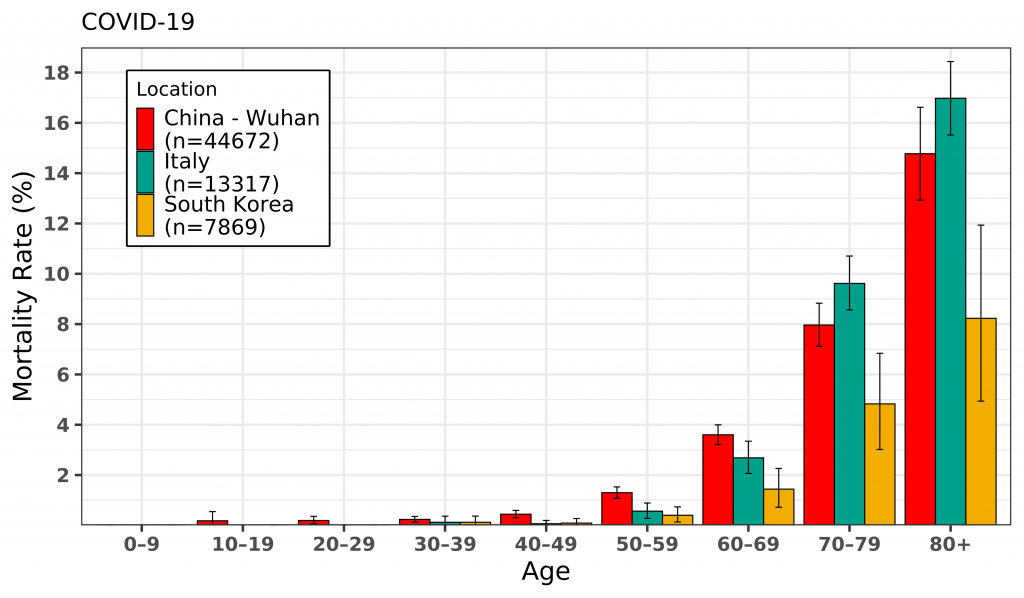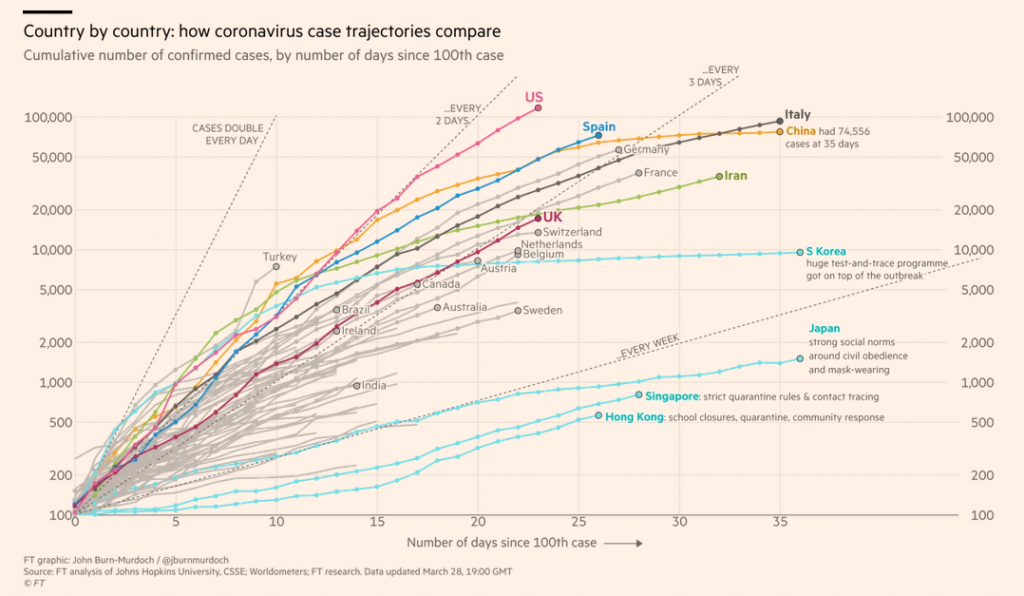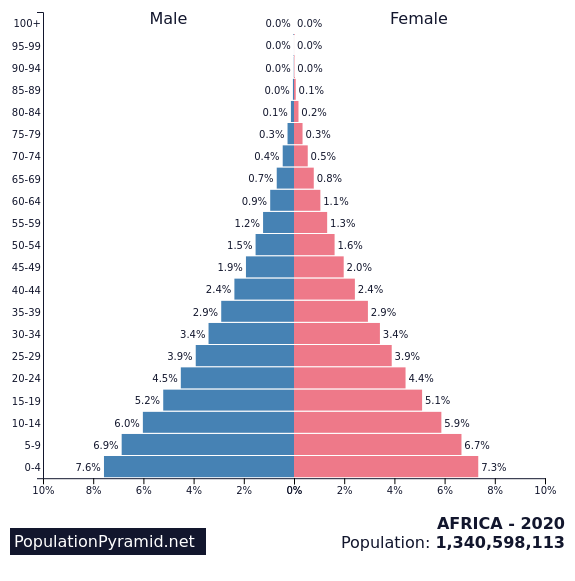
I’m worried for Africa. I’ve spent the last month dropping into the rabbit hole researching, analyzing, and experiencing the Covid-19 pandemic, and I have seen just one minor analysis of what the pandemic means in Africa.
I’m American, but have met and taught hundreds of African entrepreneurs, personally visiting many of their businesses in Africa. In the past week I’ve spoken to a dozen entrepreneurs, and none seem to understand what is about to happen across the African continent. If that is true of the business people, I fear it is also true of the masses and the government officials.
TL;DR: 5-25 million Africans will die from this pandemic in 2020, and I don’t see any way to prevent that outcome.
This long post explains why the above statement is likely true and what can and can’t be done to achieve the least number of deaths possible.
What we know
The pandemic started in Wuhan, China. It has been spreading around the world through air travel, and the frequency of travel from Wuhan explains the early epidemic hot spots. First was Japan, South Korea, Taiwan, Hong Kong, and Singapore, all with close business ties to Chinese manufacturing. Then to Northern Italy, Catalonia, Seattle, San Francisco, Los Angeles, and New York. Once the virus established beachheads in those cities, other city centers across Asia, Europe, and North America have flared up with their own outbreaks.
We know this virus is incredibly virulent, as easy to catch as a common cold, spread through speaking, sneezing, coughing, and from aerosol droplets that land on surfaces and which can survive for days.
Most troublesome, we know that people are contagious a few days before any symptoms appear, and that at least a third of people who get infected never show any symptoms and thus can quietly spread the virus to others as they continue their lives as normal.
We know that youth under 20 are mostly unaffected. The best guess is that they catch the virus but are almost all asymptomatic. At worst the mortality rate for youth is the same as influenza, with about 1 in 1,000 dying, but the actual rate probably far far lower as we just don’t know the infection rate amongst children and youth.
We know that above age 20, about 15% of infections need medical attention, and that the older the person, the more likely they’ll need a respirator to survive, and more chance that they won’t survive. Overall, the global case mortality rate is averaging between 4% and 5%. The rate various from almost 11% in Italy down to 1.2% in South Korea.

We know from China and South Korea that it is possible to contain the epidemic given massive amounts of testing, legally-enforced lockdowns, strict quarantines of everyone who tests positive, etc.
We know from Italy, the United States, most of Western Europe, and most everywhere else with more than 100 cases that without massive testing and isolation, the epidemic grows at a rate of doubling in size every 2 to 3 days, slowing to doubling every 5-7 days two weeks after the lockdowns begin.

Lastly, we know from infection model simulations that the only way to stop a virus this virulent from infecting 80%+ of a population is to either massively test and isolate everyone infected, or to socially and physically isolate 90% or more of the population. Anything short of that changes the duration of the epidemic, but not the eventual outcome.
Implications for Africa
The spread and the mortality rate of this disease depend on the demographics of a country and the social norms of family groups. The good news for Africa is that half of the 1+ billion Africans are under age 20. Given that, over half of the population is very likely to make it through this pandemic without feeling ill, even for one day.

That leaves about 500 million Africans at risk. 500 million adults, almost all of which who need to work every day to feed themselves and their families, and thus who can’t and won’t comply with a lockdown like in China or South Korea, nor a “secure in place” order like in California.
Such lockdowns simply can’t work in Africa. People need to go to the market ever few days for food, to go to centralized locations to gather water and cooking fuel. At planting time they need to buy seeds. If nothing else, they need to go to the market once per week to charge their phone and top up their minutes.
Unlike Americans and Europeans, most Africans can’t just physically separate themselves from others for a week or two at a time, venturing out only to the big, centralized, sanitized supermarket to stock up on a month’s worth of food. Such infrastructure only exists in the major African cities.
Nor will 500 million African youth stay within the walls of their homes for 60 or 90 days. The mostly-urban youth of Asia, Europe, and America are attending school over the internet and occupying their time with streaming video and video games. None of that is possible in most of Africa, and thus shutting the schools isn’t going to have the same effect in Africa as it has elsewhere.
Given the realities of life in Africa, what can be done?
What can be done?
First and foremost, the goal should be to ensure every African eats daily for the duration the epidemic. It would be a far bigger tragedy if the pandemic causes million more deaths from starvation than from Covid-19. That is a possibility if the wrong steps are taken.
One potential strategy is to empty the cities. Rather than trying to lockdown everyone at home within the cities, send everyone back to their home village (in an orderly manner, as even without such a order there could be chaos as people do this themselves, as they are doing in India).
With most everyone living on a farm, the governments can then focus on ensuring every family farm has enough seeds to grow enough food to feed the extended families. Government should distribute chicks and feed to grow as many layers and broilers as possible. Avoid as much movement between villages as possible to slow down the rate of infection across the country. Use telemedicine to treat the sick as much as possible. Evacuate the most critically ill patients back to the city hospitals when needed.
There is no way to lockdown the cities while also feeding the population in those cities. Keeping the food supply chain operating inevitably means the disease will flow from the city to the neighboring regions, and back again. It will mean the disease can jump from village to village through the cities, just as it jumped from Wuhan to Milan, and from Milan to Berlin, Paris, and Vienna.
What needs to be done is to ensure that every African has at least one meal per day. 80%+ of African are farmers or grew up on farms. Those resources are the key to keeping African alive through this pandemic. Unlike Asia, Europe, and America, most food isn’t grown on giant commercial farms. Most African food comes from smallholder farms, and those farms need to feed African for the duration of the pandemic, and beyond.
How long will this last?
If no actions are taken, exponential growth dictates that it will take 3-4 months for most every African who will ultimately be infected, to get infected. (Starting with 100 cases, 33% daily growth reaches 1 billion people in 82 days. Realistically, the growth rate eventually slows as fewer people are left to be infected, but simple models demonstrate how quickly 100 cases can spread across a country, no matter its population.)
In the U.S. and Europe, the plan is to use lockdowns to slow that natural rate for two reasons. First and foremost, in an attempt to not overwhelm the hospitals, giving the most serious cases a chance to survive through intense medical care. Africa has a fraction of the intensive care facilities found in American or Europe, and unfortunately no level of lockdown can succeed at that strategy.
Neither America nor Europe can supplement the African supply of ventilators and other equipment, as America and Europe are right now desperately trying to ramp up production to meet their own needs. Neither can China help, as their economy greatly suffered from their own lockdown and with that they’ll sell whatever they can produce to the highest bidder, which will be America and Europe, not Africa.
At best, emptying the cities could slow down the epidemic across Africa to 5-9 months: April through September, October, November, or December, 2020. By then most Africans will have either been infected and recovered, or will have been infected and died. If there are lingering outbreaks in lucky villages that escape the epidemic, small secondary outbreaks won’t effect daily life as most Africans will by then already been immune. (Assuming recovery provides immunity, which so far seems to be true, although maybe not lifetime immunity.)
What happens after the epidemic wanes? Unfortunately life doesn’t doesn’t simply go back to normal. If Europe, Asia, and America are successful in “slowing their curves”, they’ll still be in the midst of their epidemics at the end of 2020, aiming to keep the infection rate low, aiming for the eventual vaccine to let them end the pandemic without 80%+ of their population ever being infected (At best that vaccine will be available in the first half of 2021.)
This means that until the global pandemic is complete, the resource-based economy of Africa will lose its customers (with gold being the one exception). This also means that the NGOs will still be focused on their own survival, not ready to scale back up to help Africa recover. The same with the foreign direct investors. Plus there is a good chance 2021 will see quite a lot less government-based foreign aid flowing to Africa, as 2020 has already seen the largest amount of (so far promised) government spending ever in history in the U.S. and Europe, aiming to keep as much of their economies intact as possible.
In short, economically Africa is going to be on its own for the rest of 2020, and most on its own for at least 2021, if not most of the 2020s.
5-25 Million Will Die
This pandemic is too serious to not be clear and explicit as to the likely outcome. If the mortality rate is just 1%, and if all of the youth are spared, then 1% of the 500 million Africans over the age of 20 means that 5 million Africans will die in 2020.
The case mortality rate in Italy is currently almost 11%. That is no doubt inflated as they are not doing wide scale testing and no country is yet testing everyone to find the asymptomatic cases. With that in mind and between the difference in quantity and quality of Italian vs. African healthcare and the far lower number of Africans over the age of 60, the worst case mortality rate (of adults) in Africa could be 5%. That would leave 25 million African dead from this disease in 2020.
Either end of that range is tragic. The only bigger tragedy would be to add millions more dead from starvation. Since we don’t have the resources to stop the pandemic, my conclusion from this analysis is to focus all efforts toward preventing hot spots of hunger.
UPDATE: Bill Gates was asked (minute 27:30) what tools are available for the developing countries. TL;DL: Nothing. His answer is that he hopes the curve-slowing efforts in the developed countries come in time to help the developing world. And he missed the fact that the outbreak in the developing countries could be complete well before a vaccine is ready in 2021. You can watch this remarks below:
UPDATE: McKinsey posted some analysis of the coming economic impact of the pandemic on Africa: Tackling COVID-19 in Africa.
UPDATE: Others are starting to see the coming hunger issues too: (1) Kenya’s Market Infrastructure, (2) Virus Lockdowns in the Shadow Economy, (3) Chance to avert disaster in urban slums.
UPDATE: If virus and hunger were not enough to deal with, there are payments due on debt to the rich countries. World must combat looming debt meltdown in developing countries and Calls for debt relief for world’s poorest nations. Seems long overdue in this upcoming reconstruction to implement bancor (also described in Perry Mehrling’s great lecture series).
UPDATE: Arundhati Roy on the same issue now hitting India.
UPDATE: There are fewer than 2,000 ventilators total in 41 African countries, and 10 countries with none.
UPDATE: McKinsey has released its analysis of Africa’s path through the pandemic.














